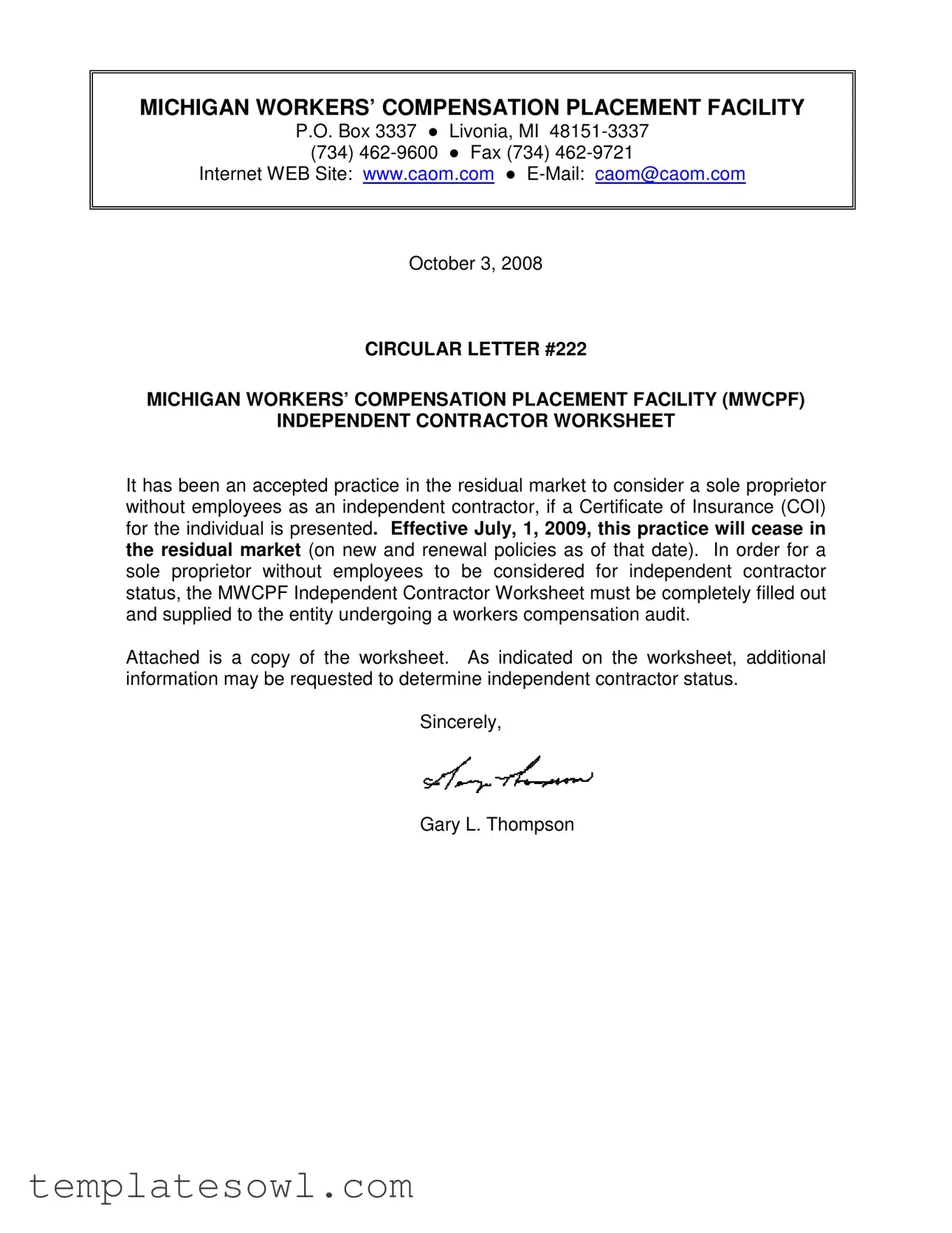MICHIGAN WORKERS’ COMPENSATION PLACEMENT FACILITY
P.O. Box 3337 Livonia, MI 48151-3337
(734) 462-9600 Fax (734) 462-9721
Internet WEB Site: www.caom.com E-Mail: caom@caom.com
October 3, 2008
CIRCULAR LETTER #222
MICHIGAN WORKERS’ COMPENSATION PLACEMENT FACILITY (MWCPF)
INDEPENDENT CONTRACTOR WORKSHEET
It has been an accepted practice in the residual market to consider a sole proprietor without employees as an independent contractor, if a Certificate of Insurance (COI) for the individual is presented. Effective July, 1, 2009, this practice will cease in the residual market (on new and renewal policies as of that date). In order for a sole proprietor without employees to be considered for independent contractor status, the MWCPF Independent Contractor Worksheet must be completely filled out and supplied to the entity undergoing a workers compensation audit.
Attached is a copy of the worksheet. As indicated on the worksheet, additional information may be requested to determine independent contractor status.
Sincerely,
Gary L. Thompson
MICHIGAN WORKERS’ COMPENSATION PLACEMENT FACILITY
INDEPENDENT CONTRACTOR WORKSHEET
TO BE COMPLETED BY THE INDEPENDENT CONTRACTOR
Policyholder Name form is being filled out for:
Subcontractor Name:
Doing Business As (DBA):
|
|
If DBA is filed, attach a copy. |
|
1. I operate as a : |
Sole Proprietor |
Partnership |
Corporation |
Limited Liability Company |
Note: If indicating |
Partnership, Corporation or Limited Liability Company, a Certificate of Workers’ |
Compensation Insurance or a properly filed Form BWC-337 must be submitted. |
|
2.The type of work I perform can be described as:
3.I hire employees or casual laborers to complete work for the named policyholder:
Yes |
|
Number hired (Attach Certificate of Workers’ Compensation Insurance) |
No |
Form 1040 SCHEDULE C (Profit or Loss from Business) may be provided as verification. |
4. I hire subcontractors to complete work for the named policyholder: Yes No If yes, additional information may be required.
5. I have General Liability coverage: Yes No
If yes, a Certificate of General Liability Insurance is required.
6.To validate my standing as an independent contractor, I state that I do not exclusively depend upon the payments of the named policyholder and have worked for the following general contractors or clients during the past twelve months.
1.
2.
3.
I acknowledge that as a sole proprietor, I am by law not covered by or subject to the Workers’ Disability Compensation Act.
I certify the above represents a true and complete statement of my status as an Independent Contractor. I understand a company representative may verify this statement at any time. If requested, I agree to provide documentation to verify my status as a sole proprietor.
Signed: |
|
|
|
|
Date: |
|
|
|
(Independent Contractor) |
Phone Number: |
|
Email Address : |
|
(Required)
This form is utilized as a test of the above individual’s independent status. By completing this form, it does not automatically remove the above individual’s exposure from the audit of the policy period in question. Additional information may be required. If independent status is proven, the exposure will not be charged.
ICW08


